Common NAICS Questions
The U.S. Census Bureau assigns and maintains only one NAICS code for each establishment based on its primary activity (generally the activity that generates the most revenue for the establishment). Since other federal government agencies, trade associations, and regulation boards maintain their own lists of business establishments and assign classification codes based on their own programmatic needs, this will vary by agency.
Yes, some agencies assign more than one NAICS codes to one establishment. For instance, the SAM (System for Award Management formerly CCR), where businesses register to become federal contractors, will accept up to 5 or 10 classification codes per establishment. You will need to contact the other agencies to find out what their policies are. For access to a list of federal government agencies, click here.
The U.S. Census Bureau is unable to provide a NAICS or SIC code for a named business over the Internet or telephone without written request.
Luckily, we at the NAICS Association can provide statistical information for specific companies with this simple company lookup tool.
Yes. By using the US Company Lookup Tool, you can purchase a company record that includes NAICS and SIC Information, DUNS Numbers, Company Size Information, Addresses, Phone Numbers, Contact Names, Lat/Long and More.
Sample Purchased Record:
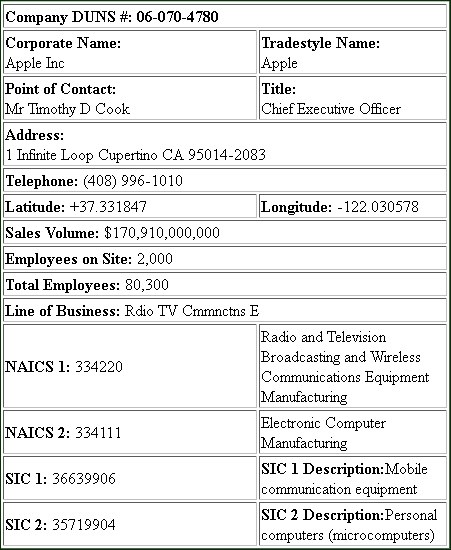
Yes! Just Use Either of the Resources Below:
NAICS to SIC Crosswalk
Enter Your NAICS Code to Find the Corresponding SIC Codes
NAICS will be reviewed every five years (in the years ending in ‘2’ or ‘7’) for potential revisions so that the classification system can keep pace with the changing economy.
The Office of Management and Budget (OMB), through its Economic Classification Policy Committee (ECPC), will solicit public comments through a notice published in the Federal Register. The notice will provide details of the format in which comments should be submitted, to whom they should be submitted, and the deadline for submission. Generally, the comment period will close 90 days after publication of the notice.
During that time, suggestions for new and emerging industries can be submitted to the ECPC. This committee will review each comment submitted to determine its feasibility and adherence to the underlying principles of NAICS, consult with the NAICS counterparts in Canada and Mexico to determine if they can accept the proposed changes that would impact 3-country comparability, and then make final recommendations to OMB for additions and changes to the NAICS manual.
This process is now completed for the 2017 revision of NAICS. The next scheduled review of NAICS will be for a potential 2022 revision.
NAICS was designed and documented in such a way to allow business establishments to self-code. There are a number of tools and references available to help you to determine the most appropriate NAICS code for your business:
You can use our Powerful Search Tool to find any NAICS code quickly and easily. Enter a keyword that describes your kind of business. A list of primary business activities containing that keyword and the corresponding NAICS codes will appear. Choose the one that most closely corresponds to your primary business activity, or refine your search to obtain other choices.
Rather than searching through a list of primary business activities you may also browse the NAICS Codes and Titles to find your code. You can select the category that applies to your business, and drill down through the more detailed levels until you find the appropriate 6-digit code.
If you know your old SIC code, you can use our Powerful Search Tool to locate the corresponding NAICS code. Simply enter the SIC code and the corresponding NAICS code(s) will appear.
To see the NAICS code associated with a specific business listing, use our US Business Directory Company Lookup Tool.
For more help with using the NAICS Search tool, click here.
To determine the correct NAICS code for your establishment, first identify the primary business activity. Then refer either to: 1) the NAICS United States Structure to search the titles from the 2-digit level down through the 6-digit, more detailed level, to find the appropriate code; or 2) the Alphabetic Index to search alphabetically for the primary activity and its corresponding code. Next, read the full description of the industry (including the narrative, cross-references, and illustrative examples), and determine if that description fits the primary business activity of your establishment.
You can obtain data for a specific NAICS industry by going to the 2007 Economic Census website. This website provides data at the sector level.
You may also get data by state, or selected metro area by using the pull-down menus in the upper right hand corner of the page. You may also obtain data from the American Fact Finder website.
You can obtain a quick report by either industry or geography by clicking on the links listed. Beginning with the 1998 data year, the annual County Business Patterns reports provide employment, payroll, number of establishments (but not sales/receipts). Click here to view the CBP data.
Every five years NAICS is reviewed for potential revisions, so that the classification system can keep pace with the changing economy. This is the only time that new NAICS codes can be considered. The Office of Management and Budget (OMB), through its Economic Classification Policy Committee (ECPC), will solicit public comments regarding changes to NAICS through a notice published in the Federal Register. The notice will provide details of the format in which comments should be submitted, how and to whom they should be submitted, and the deadline for submission. During the public comment period, suggestions for new and emerging industries can be submitted to the ECPC. The next scheduled review of NAICS will be for a potential 2027 revision. [SOURCE: US NAICS MANUAL]
NAICS is scheduled to be reviewed every 5 years for potential revisions, so that the classification system can keep pace with the changing economy. This is the only time that new NAICS codes can be considered.
The Office of Management and Budget (OMB), through its Economic Classification Policy Committee (ECPC), will solicit public comments regarding changes to NAICS through a notice published in the Federal Register.
The notice will provide details of the format in which comments should be submitted, how and to whom they should be submitted, and the deadline for submission.
Generally, the comment period will close 90 days after publication of the notice. During that time, suggestions for new and emerging industries can be submitted to the ECPC.
This committee will review each comment submitted to determine its feasibility and adherence to the underlying principles of NAICS, consult with the NAICS counterparts in Canada and Mexico to determine if they can accept the proposed changes that would impact 3-country comparability, and then make final recommendations to OMB for additions and changes to the NAICS Manual.
This process is now completed for the 2017 revision to NAICS. The next scheduled review of NAICS will be for a potential 2022 revision. It is expected that the OMB will publish a Federal Register notice soliciting comments for that revision in late 2021 or early 2022.
There is no “official” way to have a company’s SIC or NAICS code changed. Various Federal government agencies maintain their own lists of business establishments, and assign classification codes based on their own programmatic needs.
Generally, the classification codes are derived from information that the business establishment has provided on administrative, survey, or census reports. For this reason, we recommend that you contact the agency that has assigned the code that you believe should be changed.
For example, if you question the SIC or NAICS code contained on a form received from OSHA, you should contact the Department of Labor. For access to a list of Federal government agencies, visit this site.
We have both hard copy and electronic manuals available:
The NAICS Manual is the official hard copy reference containing all the NAICS codes, descriptions, and cross-references. It is the easy “desk-reference” for everything NAICS. You can also find downloadable reference files here.
A business does not ‘apply’ for a NAICS code. As explained above, statistical agencies generally assign NAICS codes based on information provided by a business on an application form, an administrative report, or on a survey or census report form.
[SOURCE: US NAICS MANUAL]NAICS was developed specifically for the collection and publication of statistical data to show the economic status of the United States.
The NAICS categories and definitions were not developed to meet the needs of procurement and/or regulatory applications.
However, other federal agencies trade associations, and regulation boards have adopted NAICS to use for procurement and regulatory purposes even though it does not entirely fit their specific needs.
The U.S. Census Bureau has no formal role as an arbitrator of statistical classification. For questions regarding other agencies’ use of the NAICS system, contact the specific agency. For access to a list of Federal government agencies, visit this site.
Of course, some will have alternate preferences, but we have found the most popular pronunciations for these codes are as follows:
NAICS is said “NAKES” and Rhymes with SNAKES.
SIC is said “Ess-Eye-Sea” or S-I-C.*
*You will notice throughout this site that a single SIC Code will be referred to as ‘AN’ SIC code as opposed to ‘A’ SIC Code for this reason.
There were 1,175 industries in 2007 NAICS United States and in 2012 NAICS United States there are 1,065 industries. For 2012, revisions were made to address changes in the economy. These included content revisions for selected areas, several title changes, and clarification of a few industry definitions. Specifically, the changes include: (1) collapsing detail in the Manufacturing sector to reduce statistical product production costs and respondent burden; (2) adding new and emerging industries; (3) the classification of distribution centers, publishers’ sales offices, and logistics service providers; (4) the classification of units that outsource all transformation activities.
Noticeable changes were made to six of the twenty NAICS sectors during the 2012 revision of NAICS. These sectors are listed below:
-
- Sector 22, Utilities – 2007 NAICS code 221119, Other Electric Power Generation, was deleted and portions of it were reclassified, resulting in the addition of five new 6-digit industries: 221114, Solar Electric Power Generation; 221115, Wind Electric Power Generation; 221116, Geothermal Electric Power Generation; 221117, Biomass Electric Power Generation; 221118, Other Electric Power Generation.
- Sector 23, Construction – Building fireproofing contractors and fireproofing flooring construction contractors were moved to 238310, Drywall and Insulation Contractors.
- Sector 31-33, Manufacturing – Major changes were made in the Manufacturing sector, with the collapsing of detail. Digital camera manufacturing was moved to newly created industry, 333316, Photographic and Photocopying Equipment Manufacturing.
- Sector 42, Wholesale Trade – Electric water heaters was moved to 423720, Plumbing and Heating Equipment and Supplies (Hydronics) Merchant Wholesalers. Gas household appliances (except gas water heaters) was moved to newly titled 423620, Household Appliances, Electric Housewares, and Consumer Electronics Merchant Wholesalers.
- Sector 44-45, Retail Trade – 2007 NAICS codes 441221, Motorcycle, ATV, and Personal Watercraft Dealers, and 441229, All Other Motor Vehicle Dealers, were collapsed into a new 6-digit industry, 441228, Motorcycle, ATV, and All Other Motor Vehicle Dealers. 2007 NAICS codes 454311, Heating Oil Dealers; 454312, Liquefied Petroleum Gas (Bottled Gas) Dealers; 454319, Other Fuel Dealers, were collapsed into a new 6-digit industry, 454310, Fuel Dealers. Subsector 443, Electronics and Appliance Stores, was restructured.
Sector 72, Accommodation and Food Services – Industries in Subsector 722, Food Services and Drinking Places, were restructured, resulting in new Industry Group 7225, Restaurants and Other Eating Places.
DOWNLOAD THE TABLE:
2017 NAICS U.S. Matched to 2012 NAICS U.S. (Full Concordance)
Highlights of NAICS Changes Include:
Crude Petroleum and Natural Gas Extraction (2012 NAICS Code 211111) will be broken into two new codes in 2017. These codes will be 211120, Crude Petroleum Extraction and 211130, Natural Gas Extraction.
Also, Natural Gas Liquid Extraction, (2012 NAICS Code 211112) will become NAICS Code 211130 in 2017.
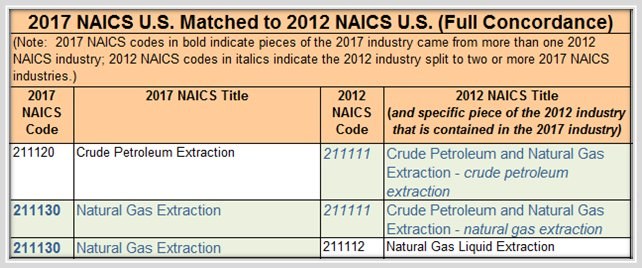
The 2012 NAICS Code for Lead Ore and Zinc Ore Mining (2012 NAICS Code 212231) is expanding to cover Nickel Ore and Lead Ore Mining (2012 NAICS Code 212234) in one inclusive 2017 NAICS Code: 212230.
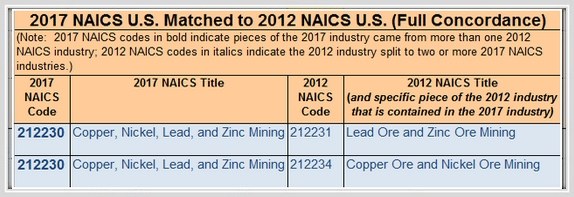
The NAICS Codes for Pump and Pumping Equipment Manufacturing (2012 NAICS Code 333911) and the Code for Measuring and Dispensing Pump Manufacturing (2012 NAICS Code 333913) will be combined in 2017 to become NAICS Code 333914, “Measuring, Dispensing and Other Pumping Equipment Manufacturing”.
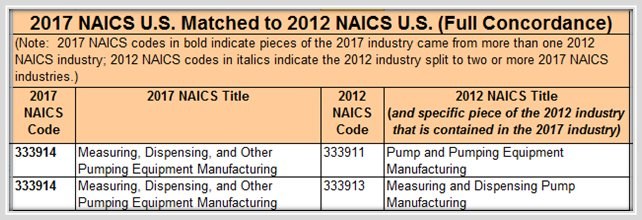
The 2012 NAICS Codes 335221, 335222, 335224 and 335228 for Household Cooking Appliance, Household Refrigerator and Home Freezer, Household Laundry Equipment and Other Major Household Appliance Manufacturing are all being combined in 2017 to the single NAICS Code: 335220, “Major Household Appliance Manufacturing”.
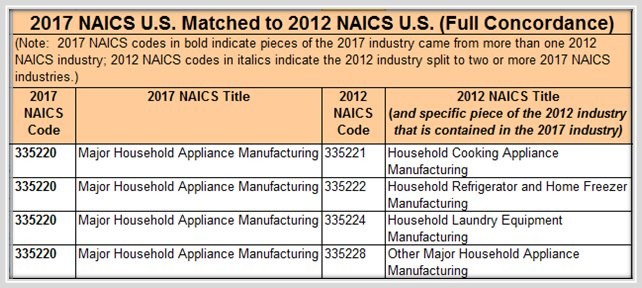
The 2012 NAICS Code 452112 is being split into two NAICS Code Classifications. The first category under 452112, Discount Department Stores (insignificant perishable grocery sales) is becoming part of NAICS code 452210, “Department Stores”, along with 2012 NAICS Code 452111 for Department Stores (except Discount Department Stores). The Second Category under 452112, (for significant perishable grocery sales) is becoming NAICS Code 452311 “Warehouse Clubs and Supercenters”, along with 2012 NAICS Code for that same category, NAICS Code 452910.
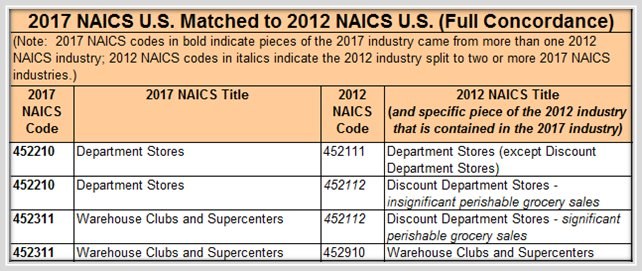
2012 NAICS Codes 454111, 454112 and 454113 for Electronic Shopping, Electronic Auctions and Mail-Order Houses are to be classified under 2017 NAICS Code 454110.
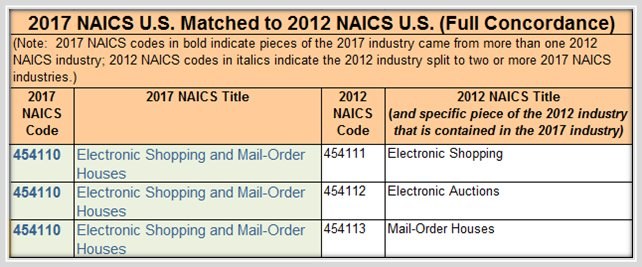
The 2012 NAICS Code 541711 will no longer encompass “Research and Development in Biotechnology (except Nanobiotechnology)”. Also, the 2012 NAICS Code 541712 will no longer encompass “Research and Development in the Physical, Engineering, and Life Sciences (except Nanotechnology and Biotechnology)”. Instead, these will each be classified under the 2017 NAICS Code 541715, “Research and Development in the Physical, Engineering, and Life Sciences (except Nanotechnology and Biotechnology)”
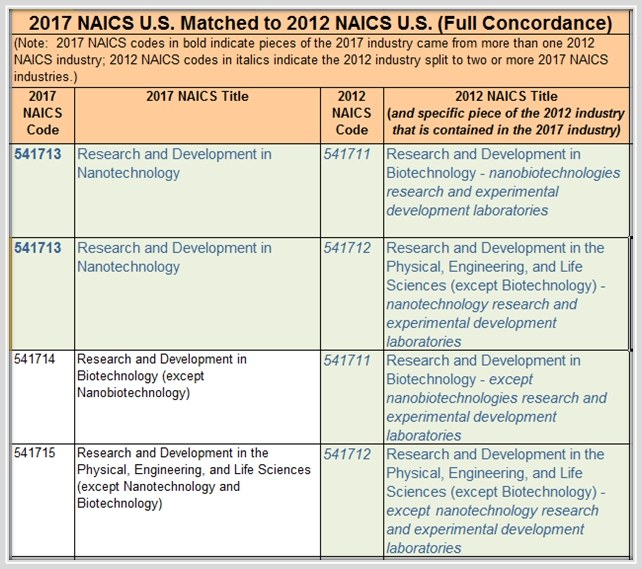
NAICS CODE CHANGES WHERE THE INDUSTRY TITLE AND DESCRIPTION ARE UNCHANGED:
| 2017 NAICS Codes |
2017 NAICS Descriptions | 2012 NAICS Codes |
2012 NAICS Descriptions |
| 452319 | All Other General Merchandise Stores | 452990 | All Other General Merchandise Stores |
| 517311 | Wired Telecommunications Carriers | 517110 | Wired Telecommunications Carriers |
| 517312 | Wireless Telecommunications Carriers (except Satellite) | 517210 | Wireless Telecommunications Carriers (except Satellite) |
| 532281 | Formal Wear and Costume Rental | 532220 | Formal Wear and Costume Rental |
| 532282 | Video Tape and Disc Rental | 532230 | Video Tape and Disc Rental |
| 532283 | Home Health Equipment Rental | 532291 | Home Health Equipment Rental |
| 532284 | Recreational Goods Rental | 532292 | Recreational Goods Rental |
| 532289 | All Other Consumer Goods Rental | 532299 | All Other Consumer Goods Rental |
A new North American Product Classification System (NAPCS) is under development, starting in nine service sectors. Whereas NAICS focuses on the input and production processes of industries, NAPCS will classify all the output of the industries of NAICS.
The long-term objective of NAPCS is to develop a market-oriented, or demand-based, classification system for products that (a) is not industry-of-origin based but can be linked to the NAICS industry structure, (b) is consistent across the three NAICS countries, and (c) promotes improvements in the identification and classification of service products across international classification systems, such as the Central Product Classification System of the United Nations.
Industries in the United States are identified by a six-digit code. Each manufacturing and mining product or service is identified by a ten-digit product code. The product coding structure represents an extension, by the U.S. Bureau of the Census, of the six-digit industry classification of the manufacturing and mining sectors. The product classification system operates so that the industrial coverage is progressively narrower with the successive addition of digits.
An establishment is generally a business or industrial unit at a single, physical location that produces or distributes goods or performs services (e.g., store, factory, farm, etc.).
An enterprise, on the other hand, may consist of more than one location performing the same or different types of economic activities. Each establishment of that enterprise is assigned a NAICS code based on its own primary activity.
An industry classification system facilitates the collection, tabulation, presentation, and analysis of data relating to establishments and ensures that data about the U.S. economy published by U.S. statistical agencies are uniform and comparable. NAICS ensures that such data are uniform and comparable among Canada, Mexico, and the United States. [SOURCE: US NAICS MANUAL]
The North American Industry Classification System (NAICS, pronounced Nakes) was developed as the standard for use by Federal statistical agencies in classifying business establishments for the collection, analysis, and publication of statistical data related to the business economy of the U.S.
NAICS was developed under the auspices of the Office of Management and Budget (OMB), and adopted in 1997 to replace the old Standard Industrial Classification (SIC) system.
It was also developed in cooperation with the statistical agencies of Canada and Mexico to establish a 3-country standard that allows for a high level of comparability in business statistics among the three countries.
NAICS is the first economic classification system to be constructed based on a single economic concept. Click here to learn more about the background, the development and the difference between NAICS and the SIC.
An industry classification system facilitates the collection, tabulation, presentation, and analysis of data relating to establishments and ensures that data about the U.S. economy published by U.S. statistical agencies are uniform and comparable. NAICS ensures that such data are uniform and comparable among Canada, Mexico, and the United States. [SOURCE: US NAICS MANUAL]
The Small Business Administration (SBA) developed size standards for each NAICS category. To find more information about the SBA size standards, click here.
You may also contact SBA’s Office of Size Standards at 202-205-6618 or via email to [email protected]
NAICS categories do not distinguish between small and large business, or between for-profit and non-profit. The Small Business Administration (SBA) develops size standards for each NAICS category. To find more information about the SBA size standards, or when the SBA will update their size standards to reflect 2022 NAICS revisions, visit the SBA Web site at www.sba.gov/federal-contracting/contracting-guide/size-standards. You may also contact SBA’s Office of Size Standards Answer Desk on 800-827-5722 or via email to [email protected]. [SOURCE: US NAICS MANUAL]
Title 13, U.S. Code, Section 9 (a) prohibits the U.S. Census Bureau from disclosing individual company activities including NAICS and SIC codes. The Census Bureau is bound by Title 13 of the United States Code. These laws not only provide authority for the work the census does, but also provides strong protection for the information collected from individuals and businesses.
Title 13 provides the following protections to individuals and businesses:
Private information is never published. It is against the law to disclose or publish any private information that identifies an individual or business such, including names, addresses (including GPS coordinates), Social Security Numbers, and telephone numbers.
The Census Bureau collects information to produce statistics. Personal information cannot be used against respondents by any government agency or court.
Census Bureau employees are sworn to protect confidentiality. People sworn to uphold Title 13 are legally required to maintain the confidentiality of your data. Every person with access to your data is sworn for life to protect your information and understands that the penalties for violating this law are applicable for a lifetime.
Violating the law is a serious federal crime. Anyone who violates this law will face severe penalties, including a federal prison sentence of up to five years, a fine of up to $250,000, or both.
Title 13, U.S. Code is available to download from the Government Printing Office here [PDF 311KB].
We have several easy to use references available:
The Industry Drill-Down provides a complete list of 6-digit codes along with links to the full descriptions and cross-reference to similar codes.
The NAICS Manual & Downloadable Reference Files can be purchased here.
There is no central government agency with the role of assigning, monitoring, or approving NAICS codes for establishments. Different agencies maintain their own lists of business establishments to meet their own programmatic needs. These different agencies use their own methods for assigning NAICS codes to the establishments on their lists. Statistical agencies assign one NAICS code to each establishment based on its primary activity. For example, the Social Security Administration assigns a NAICS code to new businesses based on information provided on their application for an Employer Identification Number. The Census Bureau generally assigns NAICS codes to businesses on its list of establishments based on information provided by the business on a survey or census report form. The Bureau of Labor Statistics initially assigns NAICS codes based on business activity information provided on an application for unemployment insurance. [SOURCE: US NAICS MANUAL]
There is no central government agency with the role of assigning, monitoring, or approving NAICS codes for establishments.
NAICS Codes are self-assigned based on the establishment’s primary activity (the activity that generates the most revenue for the establishment)
Individual establishments are assigned NAICS codes by various agencies for various purposes using a variety of methods. The U.S. Census Bureau has no formal role as an arbitrator of NAICS classification.
The U.S. Census Bureau assigns one NAICS code to each establishment based on its primary activity (the activity that generates the most revenue for the establishment) to collect, tabulate, analyze, and disseminate statistical data describing the economy of the United States.
Generally, the U.S. Census Bureau’s NAICS classification codes are derived from information that the business establishment provided on administrative, survey, or census reports. (e.g. when a company applies for an Employer Identification Number (EIN), information about the type of activity in which that business is engaged is requested in order to assign a NAICS code).
Various other government agencies, trade associations, and regulation boards adopted the NAICS classification system to assign codes to their own lists of establishments for their own programmatic needs. If you question the SIC or NAICS code contained on a form received from an agency other than the U.S. Census Bureau, you should contact that agency directly.
NAICS is a two-through-six-digit hierarchical classification code system, offering five levels of detail. Each digit in the code is part of a series of progressively narrower categories, and the more digits in the code signify greater classification detail. The first two digits designate the economic sector, the third digit designates the subsector, the fourth digit designates the industry group, the fifth digit designates the NAICS industry, and the sixth digit designates the national industry.
A complete and valid NAICS code contains six digits.
In developing NAICS, the United States, Canada, and Mexico agreed that the 5-digit codes would represent the level at which the system is comparable among the three countries. The sixth digit allows for each of the countries to have additional detail (i.e., subdivisions of a 5-digit category). In cases where the U.S. did not choose to create additional detail, the 5- and 6-digit categories within U.S. NAICS are the same, and the 6-digit US NAICS code ends in zero. In some hierarchical presentations, the 6-digit code is omitted where it is the same as the 5-digit category.
Data on international trade in goods are necessarily collected on a commodity basis, whereas NAICS and SIC, data are on an establishment basis.
Commodity groups approximating the NAICS categories were developed, however, and published for the years 1997 through 1999. (These overlap with series for groups using SIC commodity group classifications in the year 1997.)
It should be noted that some of the kinds of distinctions made in NAICS and other industry classifications cannot be made in commodity trade data. A notable example is printing and publishing.
NAICS places publishing in the new Information industry and retains only printing in manufacturing. In commodity trade data, however, the entire value of imported and exported publications is included in the goods classification “Printing, publishing and similar products.”
For additional information, please visit the USITC website.
Common SIC Questions
Yes. SIC Codes are used to identify the primary line of business for any specific company, however, many companies have more than one line of business. As such, secondary, tertiary codes and so forth may be used to identify other lines of business in which a company participates and from which it produces revenue.
Yes. By using the US Company Lookup Tool, you can purchase a company record that includes NAICS and SIC Information, DUNS Numbers, Company Size Information, Addresses, Phone Numbers, Contact Names, Lat/Long and More.
Sample Purchased Record:

Yes. By using the US Company Lookup Tool, you can purchase a company record that includes NAICS and SIC Information, DUNS Numbers, Company Size Information, Addresses, Phone Numbers, Contact Names, Lat/Long and More.
Sample Purchased Record:

Yes, Just Use Either of the Resources Below:
SIC to NAICS Crosswalk
Enter Your SIC Code to Find the Corresponding NAICS Codes
SIC to NAICS Crosswalk PDF Download
SIC Codes have changed many time since their initial creation in 1937, however, the US Government discontinued use of the Standard Industrial Classification System in 1997 and replaced it with the North American Industrial Classification System (NAICS). As such, the codes have not been updated in that time. There are, however, private businesses that have developed six, seven, and eight digit SIC Codes for marketing and identification purposes, and these businesses often update and add codes to their proprietary coding systems to reflect new industries. Those changes, however should not in any way affect your use of four digit SIC Codes for regulatory purposes.
The US Census Bureau discontinued the use of SIC Codes in 1987. They were replaced by the North American Industrial Classification System (NAICS).
SIC Codes are based on Primary Business Activities. It is a much more general and less specific classification system than the newer NAICS Codes, especially at the official, 4-digit level. You should be looking for the code that best describes what your business does.
Using the SIC Code Drilldown List to Identify Your Code:
The SIC Drilldown is broken out by the following categories: Division, Major Industry Group, Industry Group, Industry Title.
Each Code fits into one of 10 SIC Divisions. A Division breaks down into Major Industry Groups, and Industry Groups Break Down into Industry Titles. 3rd Parties such as Dun&Bradstreet have developed the 8 digit SIC system to further delineate related industry titles. As you navigate the SIC Drilldown, simply select the most appropriate title at each level to find your code.
NOTE: It is possible that the agency or firm requesting your SIC Code is interested in the 8 digit code, however most government agencies currently use the NAICS system, and where they do still use SIC Codes, may only be looking for the 4 digit code.
Using your NAICS Code to find your SIC Code:
Visit the SIC to NAICS Crosswalk Page to Find Your SIC Code. You can enter your NAICS code into the NAICS to SIC Crosswalk tool to find the corresponding SIC Codes. Where there are more than one corresponding code, simply pick the one that best describes your business activities. Alternatively, you can download the PDF with the full crosswalk for Free or Purchase the Digital File (Excel Format) at the NAICS Product Store.
Use the US Company Lookup Tool
This tool allows you to purchase the record for any company listed with Dun & Bradstreet. Records include SIC and NAICS Codes.
The Standard Industrial Classification System (SIC) was discontinued in 1997. While a number of organizations and industries still utilize the SIC Coding system, there is no official way to create a new industry within the SIC.
The US Census Bureau no longer utilizes the SIC system, however there are a number of organizations and agencies that still utilize the SIC Coding System. Traditionally, the SIC is a self assigned system, meaning your company would identify itself by the code that most accurately reflects its line of business. If an organization has you listed with an SIC Code that does not reflect your line of business properly, you would contact that specific organization and request a change.
The Latest Edition of the SIC Manual is available here.
The Latest Edition of the Digital SIC Manual is available here.
Of course, some will have alternate preferences, but we have found the most popular pronunciations for these codes are as follows:
NAICS is said “NAKES” and Rhymes with SNAKES.
SIC is said “Ess-Eye-Sea” or S-I-C.*
*You will notice throughout this site that a single SIC Code will be referred to as ‘AN’ SIC code as opposed to ‘A’ SIC Code for this reason.
The first two digits of the code identify the major industry group, the third digit identifies the industry group and the fourth digit identifies the industry.
Example
| Division | 20-39 | Manufacturing |
| Major Industry Group | 25 | Furniture and Fixtures |
| Industry Group | 252 | Office Furniture |
| Industry | 2521 | Wood Office Furniture |
Note: The digit “9” is used in the third or fourth digit position of the classification code to designate miscellaneous industries not elsewhere classified (NEC). These miscellaneous classifications are not comprised of homogeneous primary activity groups. They are grouped together and treated as a separate industry in order to retain the homogeneity of the other industries in the group.
The Standard Industrial Classification SIC is a system for classifying industries by the type of activity in which they are primarily engaged with a four-digit code. It is used by government agencies, as well as some in other countries, e.g., by the United Kingdom’s Companies House.
The Standard Industrial Classification (SIC) was originally developed in the 1930’s to classify establishments by industry. The purpose of this task was to promote the comparability of establishment data to describe the US Economy.
In the United States the SIC code is being supplanted by the six-digit North American Industry Classification System (NAICS code), which was released in 1997; however certain government departments and agencies, such as the U.S. Securities and Exchange Commission (SEC), and Occupational Safety and Health Administration (OSHA) still use the SIC Codes.
The Standard Industrial Classification System (SIC) was created in 1937 by the US Government. The census discontinued use of the SIC in 1997.
A full list of current SIC Codes can be found here.
SIC Codes are no longer assigned by the US Government as they have been replaced by NAICS (North American Industrial Classification System). However, there are many agencies and organizations both government and otherwise that do still utilize these codes for a variety of reasons. Some will assign you a code themselves, though in most cases, you will be asked to provide your code.
An example of a company that may assign you an SIC Code is Dun & Bradstreet. If more than one SIC Code is assigned to a company by D&B, the first one listed is the primary line of business. The remaining codes, if any, comprise at least 10 percent of the firm’s annual revenue. These codes can be updated by using the D&B iUpdate Service.
An example of a government agency that uses SIC Codes is the U.S. Securities and Exchange Commission. The SEC does not assign codes, however, when a company registers their IPO, they will select an SIC code by assessing its primary source of revenue. The SEC and other agencies that use these codes can usually be reached if you need to alter the code they’re using on your record.
U.S. SIC Codes are defined at the four digit level. Eight-digit SIC Codes are not official U.S. government SIC codes, therefore, historical statistical data cannot be found for any SIC Code beyond the four-digit level via government sources. Six, seven and eight-digit codes have been created by private data companies to help further classify industries for marketing and identification purposes.
Common NAICS Association Questions
For help getting set up with the BizAPI, reach out to [email protected].
• NAICS was developed specifically for the collection and publication of statistical data to foster the comparability of economic estimates for Canada, Mexico, and the United States. The NAICS categories and definitions were not developed to meet the needs of procurement and/or regulatory applications. However, other federal agencies and other organizations have adopted NAICS for procurement and regulatory purposes even though it does not entirely fit their specific needs. For questions regarding these agencies’ use of the NAICS system, contact the specific agency. [SOURCE: US NAICS MANUAL]
While the NAICS Association is the best available resource for identifying NAICS Codes, it is not a Government Agency. The system itself is managed by the Census Bureau. NAICS Association is a private company dedicated to helping Customers with all things NAICS and SIC.
We provide free and paid resources to help people understand and utilize each coding system.
Common Company Lookup Questions
The Company Lookup Tool is plugged into the Database at Dun&Bradstreet. If you are unable to find your Company Record within their database, you can sign up at their site. Check your D&B Listing here.
The Company Lookup Tool is plugged into the Dun&Bradstreet Database and is updated in large batches, millions of records at a time. If your company record is out of date, you can update it using the Update tool at Dun&Bradstreet. After updating your record with D&B, it may take up to two months to change within the Company Lookup Tool.
It is not possible to expedite this process for any one company.
On a Rare Occasion, a blank record may occur if there was an issue with the internet connection during purchase. If this occurs, simply contact us with proof of purchase (Transaction ID, or Date w/ Name on Card, or receipt), and the Search Criteria used to find the Record. We will recreate the record and email it to you. Email us this information HERE and we will get you the correct file.
When you arrive at the Company Lookup Tool on FindNaics.com, there will be a login button in the top, right-hand side. Click the button, Then plug in your Email Address and Password on the new page.
Once you are logged in, instead of a Dollar Amount being shown for Records you click to acquire, you will see the Number of Searches you are Consuming.
The US Company Lookup Tool is NOT TO BE USED to determine if a business or its Industry Codes are Valid. Only Companies that have acquired a DUNS Number, a complete record, and opted into the Marketable File appear in the Database. This means there are plenty of Valid Organizations that will not appear in our system.
Furthermore, any Company may assign any NAICS/SIC code(s) to themselves at any time, and change them at any time, without fulfilling any prerequisite or registering the change with a particular system. This means that the Primary source to confirm the Validity of an Industry code is typically with the Company itself. The only time NAICS/SIC codes aren’t completely self-assigned is when the Organization has to meet rules set forth by a government entity in order to do business in a Given Industry code in the given locale.
If trying to establish a Business relationship with someone, please direct them to this page if they are hesitating to progress due to Information found or lacking in the Company Lookup Tool.
Again, This is tool is not intended to be a Determining factor in establishing Business relationships.
The US Company Lookup Tool is a Powerful Database of US Businesses that allows you to peer directly into the Dun&Bradstreet Database for basic Firmographic Business Data including:
| DUNS Number | NAICS Codes & Descriptions | Corporate Name |
| Address | SIC Codes & Descriptions | Tradestyle Name |
| Telephone | Latitude | Point of Contact |
| Employees on Site | Longitude | Title |
| Total Employees | Sales Volume | Line of Business |
Sample Purchased Record

Not all Organizations will appear in The Company Lookup Tool. Records are derived from the Marketable Database at Dun&Bradstreet (D&B), so only Organizations with a DUNS Number may appear in the Company Lookup Tool. Typically D&B Company Records aren’t included in our system if they are lacking information, opted to be delisted from the marketable file, or are being held off the Marketable list for an undisclosed reason by D&B.
If you have a DUNS Number, try finding your record on https://iupdate.dnb.com/iUpdate/companylookup.htm. Once you Verify and Authenticate your identity, you should be able to access and update your information as needed there. If you have any issues, contact the Phone number in the link. If lacking a Record with D&B, you can sign up at their site.
Common Data Append Questions
The Process:
Describe Your Needs, Provide a Sample, Approve the Outputs, and Enjoy the Results.
From Start to Finish, a Dedicated Data Append Specialist will guide you through this short and simple process, always available to answer any questions.
Here is a Breakout of the overall Customer Experience you can expect:
1. Determining the ideal Data Append for Your Unique Needs
With dozens of Single data elements available, and four Standard record layouts, there are countless ways to customize a data append to your needs. Far from the one-size-fits-all mentality of many of our competitors, we ensure that you pay only for the data you need.
2. Delivery of a Statement of Work and Price Quote
Once your needs have been determined, a Statement of Work will be delivered to your inbox, outlining the project in clear terms.
3. Sample File Append
We provide a free sample append of up to 300 records to demonstrate the exact quality of results you can expect.
4. Sample Review & Adjustment
Your Dedicated Data Append Specialist will review your sample file and make adjustments as needed to ensure your data matches with the best possible results.
5. Submit the Full File
Now that the data has been adjusted for optimum results, the full file is submitted to the data append system.
6. Success!
Your file is returned to you with actionable business intelligence!
Get the Best Results at the Best Price >>> Get a Data Append Quote
“Data append” refers to a process that involves adding new data elements to an existing database. An example of a common data append would be the enhancement of a company’s customer files. Companies often collect basic information on their clients such as phone numbers, emails, or addresses. A data append takes the information they have, matches it against a larger database of business data, allowing the desired missing data fields to be added.
The NAICS Association offers a wide range of Data Append Services including Phone Appends, NAICS & SIC Code Appends, and More.
Appending a File refers to a process that involves adding new data elements to an existing database. An example of a common file append (or data append) would be the enhancement of a company’s customer files. Companies often collect basic information on their clients such as phone numbers, emails, or addresses. A data append takes the information they have, matches it against a larger database of business data, allowing the desired missing data fields to be added.
The NAICS Association offers a wide range of Data Append Services including Phone Appends, NAICS & SIC Code Appends, and More.
To clean data is to run an existing database against a more accurate, complete database in order to correct for corrupt, inaccurate, or outdated data. Data cleansing, in practice, is often used by companies who collect data on their customers. Customer information such as business name, contact name, address, phone number etc. are recorded by the company, but by the end of the year, much of this data is inaccurate or out of date, whether due to businesses changing locations, changing employees, companies closing, etc. Data cleaning is a byproduct of the data append process, which allows for the addition of other vital data elements such as NAICS Codes, Company Size Information and more.
A data append is a process that involves adding new data elements to an existing database. An example of a common data append would be the enhancement of a company’s customer files. Companies often collect basic information on their clients such as phone numbers, emails, or addresses. A data append takes the information they have, matches it against a larger database of business data, allowing the desired missing data fields to be added.
The NAICS Association offers a wide range of Data Append Services including Phone Appends, NAICS & SIC Code Appends, and More.
“Phone Append” Refers to a process that involves adding phone numbers to an existing database. An example of a phone append in practice would be the enhancement of a company’s customer files. Companies often collect basic information on their clients such as business names and addresses. A phone append process takes the information they have, matches it against a larger database of business data, allowing them to add the missing phone number to the database, or in many cases, update the phone numbers already on file in the event of a change.
The NAICS Association offers a wide range of Data Append Services including Phone Appends, NAICS & SIC Code Appends, and More.
A Reverse Email Append is a data append process that involves matching a database of email addresses against a larger business database in order to obtain vital marketing data such as Company Name, Address, Phone Number, Contacts, Company Size Information and more.
With a Reverse Email Append from NAICS Association, you can add any of four valuable Standard Record Layouts to Your Prospect File, or any of over a dozen single data elements.
“Data Enhancement” is a process that involves adding new data elements to an existing database. An example of a common data append would be the addition of necessary data to a company’s customer files. Companies often collect basic information on their clients such as phone numbers, emails, or addresses. A data append, or data enhancement, takes the information they have, matches it against a larger database of business data, allowing the desired missing data fields to be added.
The NAICS Association offers a wide range of Data Append Services including Phone Appends, NAICS & SIC Code Appends, and More.
DATA APPENDS
Accurately Update, Cleanse and Append Mission-Critical Data to your Existing Business Databases. Dozens of Valuable Firmographic Data Elements Available!
COMPANY LOOKUP
Search over 19 million US Businesses to find NAICS Codes, SIC Codes, DUNS Numbers, Company Size Info and More. View One Listing or Purchase a Subscription for Multiple Lookups.
E-MAIL LISTS
Don’t Waste Money on Dead, Unverified E-Mail Addresses. NAICS Association Offers Only the Most Trusted and Reliable Opt-In Business Contact Email Addresses Available.


